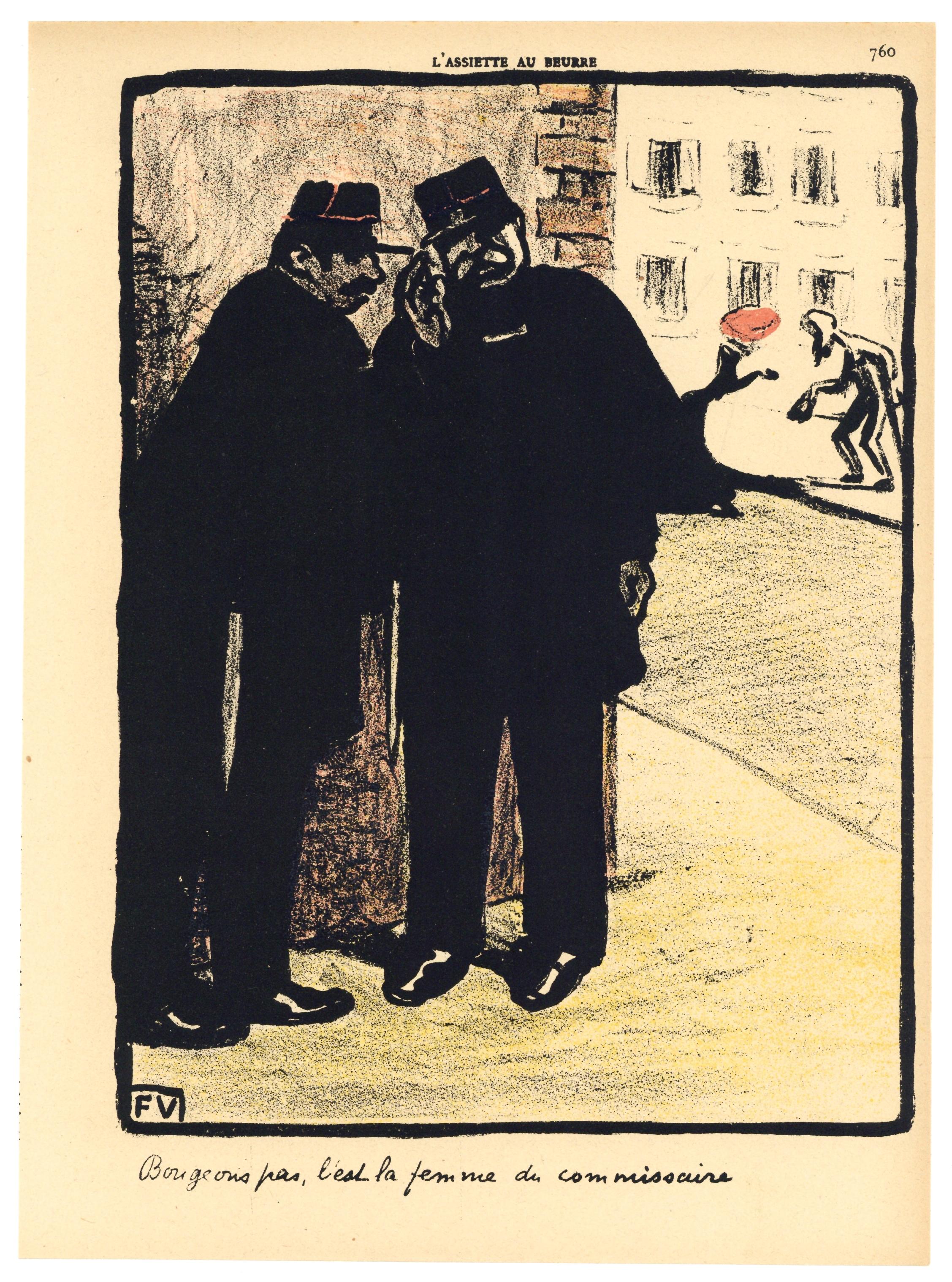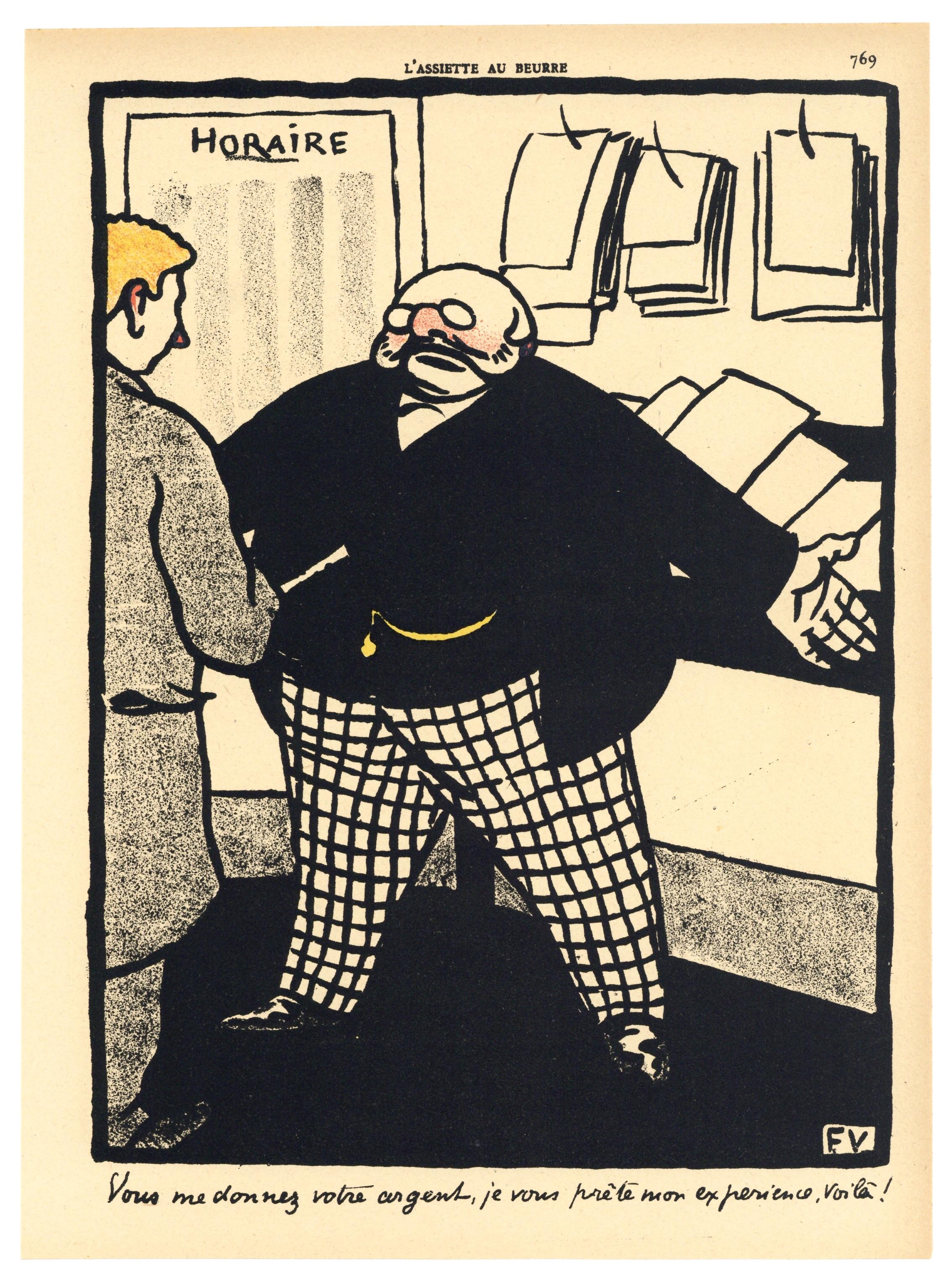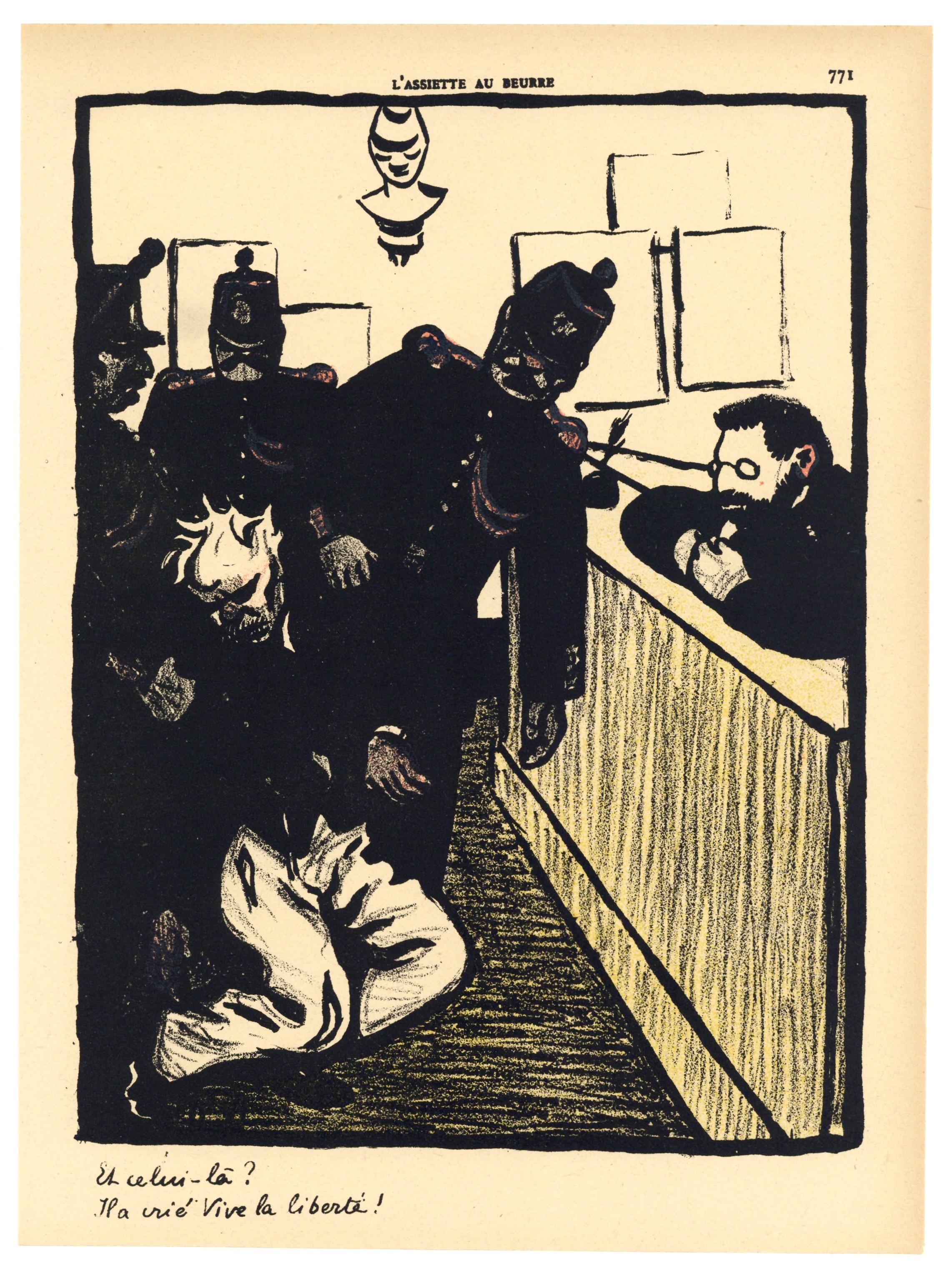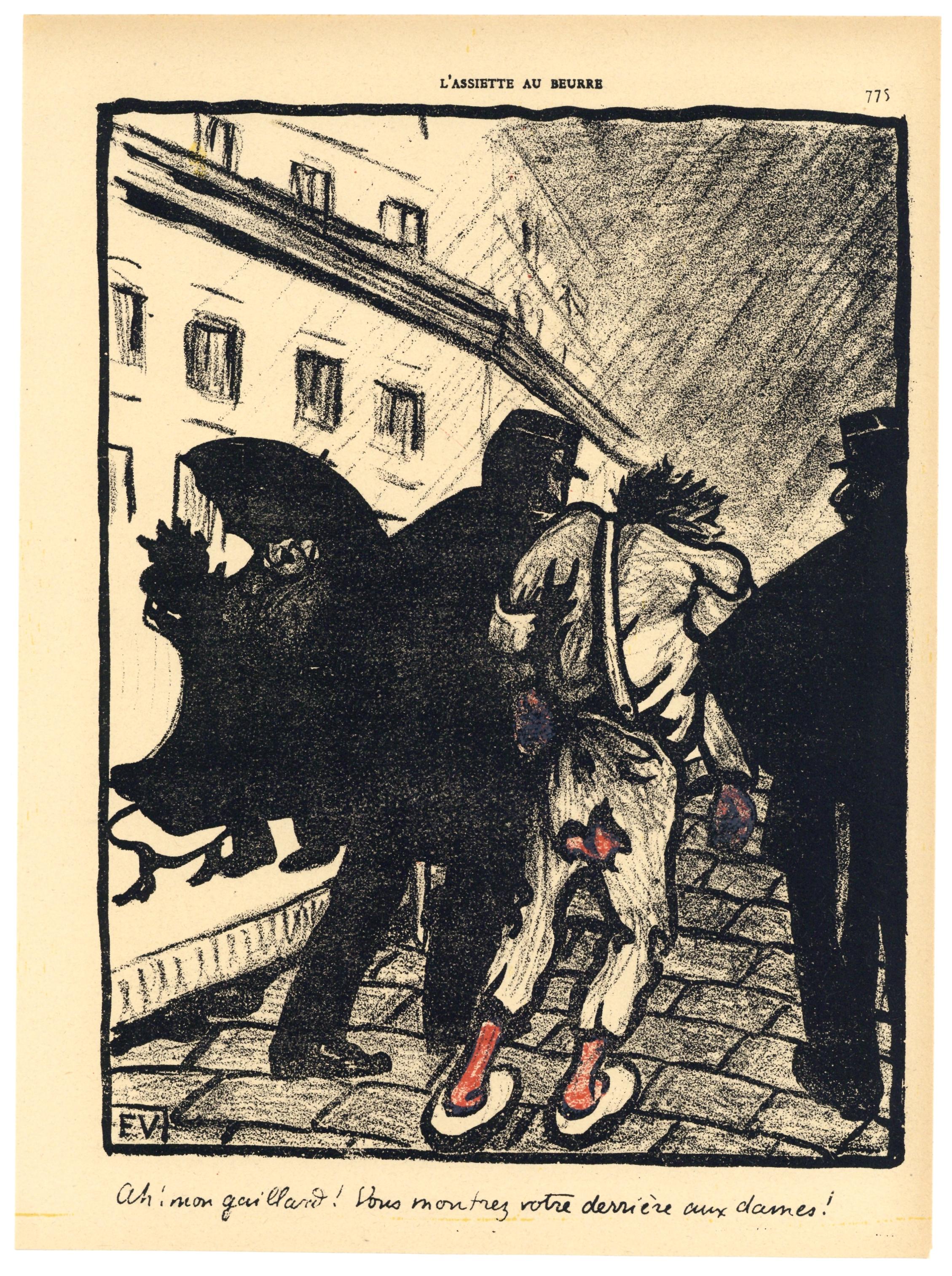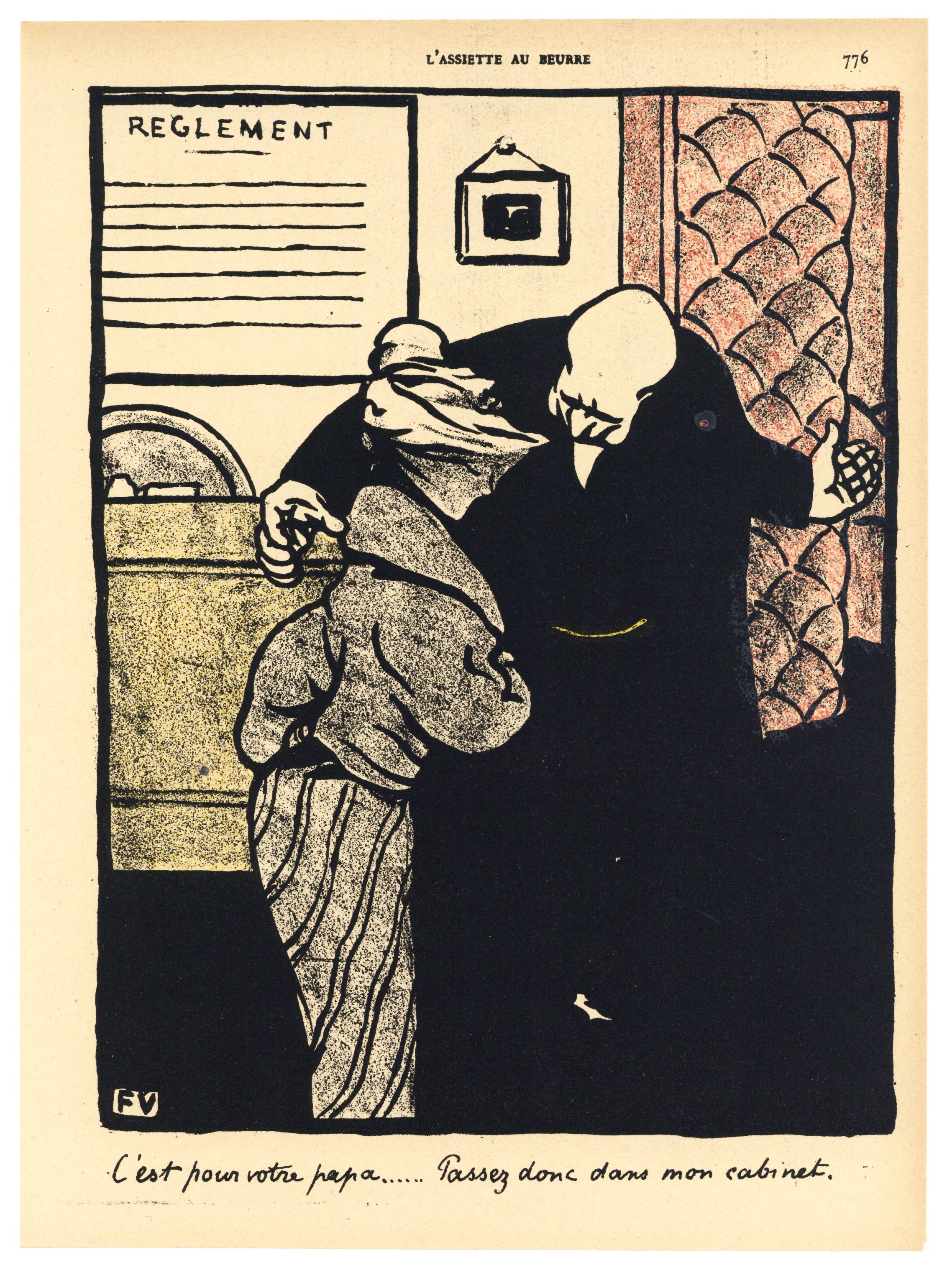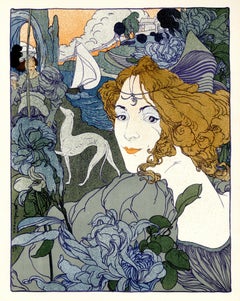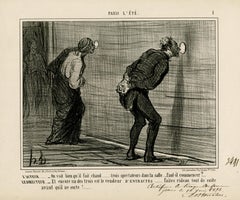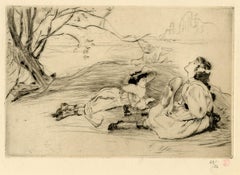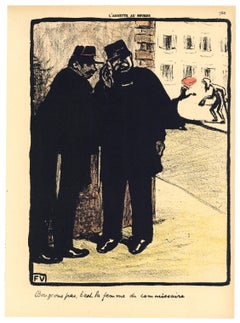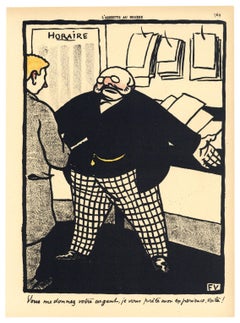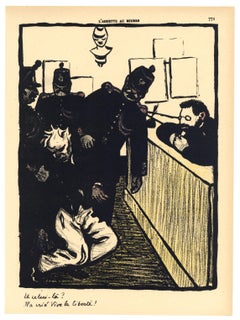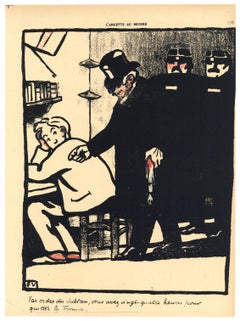Want more images or videos?
Request additional images or videos from the seller
1 of 8
Félix VallottonLes Amateurs d'Estampes1892
1892
$775
£598.13
€680.94
CA$1,106.63
A$1,207
CHF 635.99
MX$14,475.14
NOK 8,007.87
SEK 7,471.18
DKK 5,085.40
About the Item
Les Amateurs d'Estampes
Woodcut, 1892
Initialed in the plate lower left
Titled below image: "Gravure originale sur bois par F. Vallotton"
Reference: Valloton and Goerg 107c, with the purple address stamp upper right center (see photo)
Condition: Excellent
Aging to sheet
One spot of printers ink outside of the image in the upper margin
Block size: 7 3/8 x 10 inches
Sheet size: 10 1/8 x 12 3/4 inches
Condition: Very good, aging (yellowing) to the paper, more pronounced at the edges of the sheet
Provenance: Edmund Sagot (1881-1917), noted Parisian art dealer and print publisher
By decent
Vallotton was a noted member of the Nabi, highly regarded for his paintings and original woodcuts. His works are in most major museums.
An impression of this image is in the collection of numerous museums.
Thank you for your interest in the Vallotton woodcut, Les Amateurs d’Estampes (Print Lovers).
It depicts print collectors admiring the new offerings in the window of the Sagot Gallery in Paris.
The woodcut is the second published version of the address card for Edmund Sagot the noted Paris art gallery with the change of address in lavender ink. It had moved and hence the change of address was necessary for publicity.
The woodcut was created in 1892. It is unsigned as all the address cards are. There are two size variants, this being the larger of the two. It is printed on a tan wove paper. It is in excellent original condition.
The provenance is from the Heirs of Edmund Sagot (1857-1917). by decent. The Sagot family was noted for selling posters, fine prints and original works of art. Edmund’s brother Clovis, was Picasso’s first dealer in Paris.
The image is documented in the Vallotton and Goerg catalog raisonne in entry 107c
Impressions of this image can be found in many museums including:
Bibliothèque nationale de France
De Young/Legion of Honor/Fine Art Museums of San Francisco
Newfields, Indianapolis Museum of Art
National Gallery of Australia
Musee Des Beaux-Arts du Canada
Van Gogh Museum
Museum of Fine Arts, Houston
Portland Art Museum
Kunst Museum, Holland
Philadelphia Museum of Art
Yale University Art Gallery
Félix Vallotton, in full Félix Edouard Vallotton, (born December 28, 1865, Lausanne, Switzerland—died December 28, 1925, Paris, France), Swiss-born French graphic artist and painter known for his paintings of nudes and interiors and in particular for his distinctive woodcuts.
Vallotton was raised in a traditional bourgeois and Protestant household. After completing secondary school, he left Lausanne in 1882 for Paris to pursue art studies. Though he was accepted by the École des Beaux-Arts, he chose to attend the less traditional Académie Julian, where he studied with French painters Jules Lefebvre and Gustave Boulanger and enjoyed virtually free rein over his pursuits. He took the opportunity to study graphic arts—lithography and other methods of printmaking. He exhibited publicly for the first time in 1885 at the Salon des Artistes Français—the oil painting Portrait of Monsieur Ursenbach, the subject of which was an American mathematician and neighbour of the artist. In 1889 Vallotton exhibited at the Exposition Universelle in Paris as the representative from Switzerland and won honourable mention for the same portrait.
"The Starry Night," oil on canvas painting by Vincent van Gogh, 1889. In the Museum of Modern Art, New York City. 73.7 x 92.1 cm. (Post-impressionism)
Britannica Quiz
Famous Paintings Quiz
While at the Académie Julian, Vallotton had become friends with and protégè of artist and printmaker Charles Maurin, who introduced him to the art of woodcut. Maurin also introduced Vallotton to the haunts of Montmartre—the cafés and cabarets such as Le Chat Noir, where he met artist Henri de Toulouse-Lautrec. Vallotton moved to live near Montparnasse, the city’s slumlike breeding ground for artists, poets, musicians, and writers, as he drew closer to Toulouse-Lautrec and the bohemian culture of Paris. To make ends meet, he began selling prints of drawings he had made after Rembrandt and Jean-François Millet. In 1890 he also began contributing art reviews to the Gazette de Lausanne, an appointment he maintained through 1897.
Vallotton worked in woodcut almost exclusively throughout the 1890s. In 1892 he began associating with a group of artists called the Nabis (from Hebrew navi, meaning “prophet,” or “seer”)—Édouard Vuillard, Pierre Bonnard, Ker-Xavier Roussel, and Maurice Denis. Vallotton exhibited with them for the first time that year at Saint-Germain-en-Laye. Though only loosely affiliated with the group, Vallotton, like them, looked to Symbolist artists and to the Japanese tradition of woodcut. Both stressed the flatness of the surface and the use of simplified abstract forms, strong lines (evident in Vallotton’s prints), and bold colours (evident in his paintings of the period, his Paris street scenes from the mid-1890s, for example). Of the paintings he completed in that period, Bathers on a Summer Evening (1892–93) attracted the most attention. That large-scale composition of women of various ages and in various stages of undress was exhibited at the Salon des Indépendants in spring 1893, and it shocked the crowds with its eroticism.
During the 1890s Vallotton also became more politically engaged and communicated his sentiments through his prints, which were printed in Paris’s literary and political publications such as Le Rire, Le Revue blanche, L’Assiette au beurre, and Le Courrier français, as well as in Pan (Berlin), Die Jugend (Munich), and the U.S. publications Scribner’s and The Chap-Book. He was particularly vocal about his support for Alfred Dreyfus at the time of the Dreyfus affair (1894). Valletton’s woodcut The Age of Paper (1898), published on the January cover of Le Cri de Paris, shows figures reading newspapers, all of which are Parisian publications known to be pro-Dreyfus. Other notable political woodcut prints include The Charge and The Demonstration (both 1893).
Vallotton used woodcuts for nonpolitical purposes as well. He worked in the medium to depict simple yet striking intimate interior scenes of nudes, bathers, romantic and sometimes private moments between couples, and musicians playing their instruments. His woodcuts attracted international attention and acclaim. Like the Nabi painters, Vallotton created many interiors (paintings and woodcuts), including his best-known series, titled Intimacies (published in La Revue blanche in 1898), 10 woodcuts depicting private marital moments that allude to adultery and deceit. He also designed a theatre playbook cover for Swedish dramatist August Strindberg’s The Father (1894) and served as illustrator for several books throughout the 1890s, such as Jules Renard’s The Mistress and Remy de Gourmont’s The Book of Masks (both 1896).
Get a Britannica Premium subscription and gain access to exclusive content.
In 1898 Vallotton was the subject of a monograph by German art critic Julius Meier-Graefe. In 1899 he married Gabrielle Rodrigues-Henriques, a wealthy Jewish widow, daughter of art dealer Alexandre Bernheim. Vallotton’s marriage not only landed him back in the bourgeois world in which he had been raised, but it also escalated his career, as he was given many opportunities to exhibit at his father-in-law’s Galerie Bernheim-Jeune. Vallotton became a naturalized French citizen in 1900.
Though he had been painting throughout his career, at the beginning of the 20th century he shifted his focus away from printmaking to oil painting, creating many nudes, as well as landscapes, still-life paintings, interiors, and portraits—all rendered in a simplified realist manner that has been likened to that of Gustave Courbet and J.-A.-D. Ingres. Vallotton painted portraits of members of the Paris cultural elite, including Félix Fénéon (1896), Thadée Natanson (1897), Ambroise Vollard (1901–02), Gaston and Josse Bernheim-Jeune (1901), Paul Verlaine (1902), and Gertrude Stein (1907), and the very large The Five Painters (1902–03)—a group portrait of Nabi artists Bonnard, Vuillard, Charles Cottet, Roussel, and Vallotton engaged in conversation around a desk. He painted his wife numerous times, usually involved in domestic activity. By 1907 Vallotton was also trying his hand at writing, penning a novel that year (La Vie meurtrière, published posthumously in 1930; “The Murderous Life”) and several unpublished plays over the course of several years.
Throughout the 1910s Vallotton exhibited his work regularly and, after nearly 15 years, returned to woodcut to produce the antiwar series C’est la guerre! (1915; “This is War!”). Increasingly consumed with the ravages of World War I, Vallotton applied and was accepted in late 1916 to be part of a group of artists to visit the front lines and witness the drama of war in person. Several works emerged from that experience, including Ruins at Souain and Verdun (both 1917), an abstract, Futurist-inspired depiction of battle. He also published in Les Écrits nouveaux the essay “Art et Guerre,” (1917; “Art and War”), in which he described the challenges of conveying the realities of war through art.
The last 10 years of Vallotton’s career were less successful. In ill health, Vallotton saw waning appreciation for his art. He continued to make art, however, until he died of cancer at age 60. Though he is most often associated with the Nabis, he never strictly aligned himself with the movement. He has proven difficult to categorize within the framework of art history, showing a range of influences—the Old Masters, Symbolism, Realism, Post-Impressionism, and Japonism (a movement that assimilated Japanese aesthetics). Art critics and historians credit Vallotton with reviving the art of woodcut, which was then adopted after 1905 by Expressionist artists such as Erich Heckel and Ernst Ludwig Kirchner and subsequently became a mainstay of modern art.
Naomi Blumberg for Encyclopedia Britannica
- Creator:Félix Vallotton (1865 - 1925, French, Swiss)
- Creation Year:1892
- Dimensions:Height: 10.125 in (25.72 cm)Width: 12.75 in (32.39 cm)
- Medium:
- Movement & Style:
- Period:
- Condition:
- Gallery Location:Fairlawn, OH
- Reference Number:Seller: FA52641stDibs: LU14016519552
About the Seller
5.0
Recognized Seller
These prestigious sellers are industry leaders and represent the highest echelon for item quality and design.
Gold Seller
Premium sellers maintaining a 4.3+ rating and 24-hour response times
Established in 1978
1stDibs seller since 2013
828 sales on 1stDibs
Typical response time: <1 hour
Associations
International Fine Print Dealers Association
- ShippingRetrieving quote...Shipping from: Fairlawn, OH
- Return Policy
More From This Seller
View AllEn passant (Passing by)
By Louis Legrand
Located in Fairlawn, OH
En passant (Passing by)
Drypoint, 1909
Unsigned (as issued in the deluxe portfolio)
From the album "Les Bars" (8 plates plus cover illustration)
Edition: 30, this state with remarque
Published by Gustav Pellet, Paris
A very rich impression wwith burr
Condition: Excellent
Image/Plate size: 9 7/8 x 6 3/8 inches
Reference: Arwas 391a (remarque)
Exteens 277 i/II
IFF 148 (portfolio)
Louis Auguste Mathieu Legrand (29 September 1863 – 1951) was a French artist, known especially for his aquatint engravings, which were sometimes erotic. He was awarded the Légion d'honneur for his work in 1906.
Life
Legrand was born in the city of Dijon in the east of France. He worked as a bank clerk before deciding to study art part-time at Dijon's Ecole des Beaux-Arts. He won the Devosge prize at the school in 1883.[2] In 1884 Legrand studied engraving under the Belgian printmaker Félicien Rops.
Legrand's artworks include etchings, graphic art and paintings. His paintings featured Parisian social life. Many were of prostitutes, dancers and bar scenes, which featured a sense of eroticism. According to the Hope Gallery, "Louis Legrand is simply one of France's finest early twentieth century masters of etching." His black and white etchings especially provide a sense of decadence; they have been compared to those of Henri de Toulouse-Lautrec, though his drawings of the Moulin Rouge, the can-can dance and the young women of Montmartre preceded Toulouse-Lautrec's paintings of similar scenes. He made over three hundred prints of the night life of Paris. They demonstrate "his remarkable powers of observation and are executed with great skill, delicacy, and an ironic sense of humor that pervades them all."
Two of his satirical artworks caused him to be tried for obscenity. The first, "Prostitution" was a symbolic drawing which depicted a naked girl being grasped by a dark monster which had the face of an old woman and claws on its hands; the second, "Naturalism", showed the French novelist Émile Zola minutely studying the thighs of a woman with a magnifying glass. Defended by his friend the lawyer Eugène Rodrigues-Henriques (1853–1928), he was found not guilty in the lower court, but was convicted in the appeal court and then given a short prison sentence for refusing to pay his fine.
Legrand was made famous by his colour illustrations for Gil Blas magazine's coverage of the can-can, with text by Rodrigues (who wrote under the pseudonym Erastene Ramiro). It was a tremendous success, with the exceptional quantity of 60,000 copies of the magazine being printed and instantly sold out in 1891.
In 1892, at the instigation of the publishing house Dentu, Legrand made a set of etchings of his Gil Blas illustrations. The etchings were published in a book, Le Cours de Danse Fin de Siecle (The End of the Century Dance Classes).
Legrand took a holiday in Brittany, which inspired him to engrave a set of fourteen lithographs of simple country life called Au Cap de la Chevre (On Goat Promontory). It was published by Gustave Pellet who became a close friend of Legrand's. Pellet eventually published a total of 300 etchings by Legrand, who was his first artist; he also published Toulouse-Lautrec and Félicien Rops among others.
He did not only work in graphics; he exhibited paintings at the Paris salon of the Société Nationale des Beaux-Arts starting in 1902. In 1906 he was made a chevalier of the Légion d'honneur.
Legrand died in obscurity in 1951. A retrospective exhibition was held at the Félicien Rops museum in Namur, Belgium in 2006 to celebrate his graphic art. The art collector Victor Arwas published a catalogue raisonné for the occasion.
Books illustrated
de Maupassant, Guy: Cinq Contes Parisiens, 1905.
Poe, Edgar Alan: Quinze Histoires d'Edgar Poe...
Category
Early 1900s Art Nouveau Interior Prints
Materials
Drypoint
Retour (Homecoming)
By Georges De Feure
Located in Fairlawn, OH
Retour
Color lithograph, 1897
Signed in the stone lower left edge of the image (see photo)
As published in "L'Estampe Moderne"
L'Estampe Moderne appeared each month as a portfolio of...
Category
1890s Art Nouveau Figurative Prints
Materials
Lithograph
L'ACTEUR . . . . - On voit bien qu'il fait chaud . . . . . . . trois spectateurs
By Honoré Daumier
Located in Fairlawn, OH
L'ACTEUR . . . . - On voit bien qu'il fait chaud . . . . . . . trois spectateurs dans la salle ..... faut-il commencer ? . . . .
LE DIRECTEUR .- Et encore un des trois est le vendeu...
Category
1850s Romantic Figurative Prints
Materials
Lithograph
A L'Ombre (In Shadow)
By Louis Legrand
Located in Fairlawn, OH
A L'Ombre (In Shadow)
Etching & drypoint, 1905
Signed with the red stamp of the publisher Pellet (see photo)
Edition: 50 on velin paper, signed and numbered
Publisher: Gustav Pellet, Paris (his red stamp lower right, recto; Lugt 1193)
Condition: Excellent
Image/Plate size: 5-7/8 x 8-5/8" (14.8 x 21.8 cm.)
Sheet size: 11 5/8 x 17 1/8"
Reference: IFF 119
Exteens 229
Arwas 256 v/V
Louis Auguste Mathieu Legrand (29 September 1863 – 1951) was a French artist, known especially for his aquatint engravings, which were sometimes erotic. He was awarded the Légion d'honneur for his work in 1906.
Life
Legrand was born in the city of Dijon in the east of France. He worked as a bank clerk before deciding to study art part-time at Dijon's Ecole des Beaux-Arts. He won the Devosge prize at the school in 1883.[2] In 1884 Legrand studied engraving under the Belgian printmaker Félicien Rops.
Legrand's artworks include etchings, graphic art and paintings. His paintings featured Parisian social life. Many were of prostitutes, dancers and bar scenes, which featured a sense of eroticism. According to the Hope Gallery, "Louis Legrand is simply one of France's finest early twentieth century masters of etching." His black and white etchings especially provide a sense of decadence; they have been compared to those of Henri de Toulouse-Lautrec, though his drawings of the Moulin Rouge, the can-can dance and the young women of Montmartre preceded Toulouse-Lautrec's paintings of similar scenes. He made over three hundred prints of the night life of Paris. They demonstrate "his remarkable powers of observation and are executed with great skill, delicacy, and an ironic sense of humor that pervades them all."
Two of his satirical artworks caused him to be tried for obscenity. The first, "Prostitution" was a symbolic drawing which depicted a naked girl being grasped by a dark monster which had the face of an old woman and claws on its hands; the second, "Naturalism", showed the French novelist Émile Zola minutely studying the thighs of a woman with a magnifying glass. Defended by his friend the lawyer Eugène Rodrigues-Henriques (1853–1928), he was found not guilty in the lower court, but was convicted in the appeal court and then given a short prison sentence for refusing to pay his fine.
Legrand was made famous by his colour illustrations for Gil Blas magazine's coverage of the can-can, with text by Rodrigues (who wrote under the pseudonym Erastene Ramiro). It was a tremendous success, with the exceptional quantity of 60,000 copies of the magazine being printed and instantly sold out in 1891.
In 1892, at the instigation of the publishing house Dentu, Legrand made a set of etchings of his Gil Blas illustrations. The etchings were published in a book, Le Cours de Danse Fin de Siecle (The End of the Century Dance Classes).
Legrand took a holiday in Brittany, which inspired him to engrave a set of fourteen lithographs of simple country life called Au Cap de la Chevre (On Goat Promontory). It was published by Gustave Pellet who became a close friend of Legrand's. Pellet eventually published a total of 300 etchings by Legrand, who was his first artist; he also published Toulouse-Lautrec and Félicien Rops among others.
He did not only work in graphics; he exhibited paintings at the Paris salon of the Société Nationale des Beaux-Arts starting in 1902. In 1906 he was made a chevalier of the Légion d'honneur.
Legrand died in obscurity in 1951. A retrospective exhibition was held at the Félicien Rops museum in Namur, Belgium in 2006 to celebrate his graphic art. The art collector Victor Arwas published a catalogue raisonné for the occasion.
Books illustrated
de Maupassant, Guy: Cinq Contes Parisiens, 1905.
Poe, Edgar Alan: Quinze Histoires d'Edgar Poe...
Category
Early 1900s Art Nouveau Landscape Prints
Materials
Etching
Les Pelerins d'Emmaus (The Pilgrims of Emmaus)
By Maurice Denis
Located in Fairlawn, OH
Les Pelerins d'Emmaus (The Pilgrims of Emmaus)
After a 1894 painting by Denis in the Van Gogh Museum (see photo)
Color lithograph, 1895
Signed in pencil ...
Category
1890s French School Figurative Prints
Materials
Lithograph
Programme poour Le Chariot de Terre Cutte
By Henri de Toulouse-Lautrec
Located in Fairlawn, OH
Programme poour Le Chariot de Terre Cutte
Lithograph printed in blue on pink tint thin wove paper, 1895
Signed with the artist's "TL" monogram (see photo) lower center edge
Published...
Category
1890s Art Nouveau Portrait Prints
Materials
Lithograph
You May Also Like
original lithograph
By Félix Vallotton
Located in Henderson, NV
Medium: original lithograph. Printed in Paris in 1902 for the special Felix Vallotton issue of L'Assiette au Beurre on the theme of Crimes et Chatiments (Crime and Punnishment). Size...
Category
Early 1900s Prints and Multiples
Materials
Lithograph
original lithograph
By Félix Vallotton
Located in Henderson, NV
Medium: original lithograph. Printed in Paris in 1902 for the special Felix Vallotton issue of L'Assiette au Beurre on the theme of Crimes et Chatiments (Crime and Punnishment). Size...
Category
Early 1900s Prints and Multiples
Materials
Lithograph
original lithograph
By Félix Vallotton
Located in Henderson, NV
Medium: original lithograph. Printed in Paris in 1902 for the special Felix Vallotton issue of L'Assiette au Beurre on the theme of Crimes et Chatiments (Crime and Punnishment). Size...
Category
Early 1900s Prints and Multiples
Materials
Lithograph
original lithograph
By Félix Vallotton
Located in Henderson, NV
Medium: original lithograph. Printed in Paris in 1902 for the special Felix Vallotton issue of L'Assiette au Beurre on the theme of Crimes et Chatiments (Crime and Punnishment). Size...
Category
Early 1900s Prints and Multiples
Materials
Lithograph
original lithograph
By Félix Vallotton
Located in Henderson, NV
Medium: original lithograph. Printed in Paris in 1902 for the special Felix Vallotton issue of L'Assiette au Beurre on the theme of Crimes et Chatiments (Crime and Punnishment). Size...
Category
Early 1900s Prints and Multiples
Materials
Lithograph
original lithograph
By Félix Vallotton
Located in Henderson, NV
Medium: original lithograph. Printed in Paris in 1902 for the special Felix Vallotton issue of L'Assiette au Beurre on the theme of Crimes et Chatiments (Crime and Punnishment). Size...
Category
Early 1900s Prints and Multiples
Materials
Lithograph
More Ways To Browse
Antique Encyclopedias
Encyclopedia Antique
Antique Hebrew
Antique Kunst
Antique Steins
Antique Writing Pen
Dali Woodblock
Daumier Etchings
David Hockney 1984 Olympic
David Hockney Paper Pools
David Hockney Yves Marie
David Shrigley Black Cats
Drew Straker
Egon Schiele Posters
Elvis Presley Signed
Emile Souply
Emilie Floge
En Van Rijn
